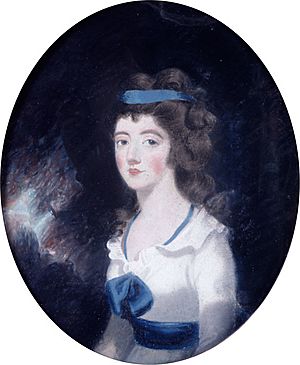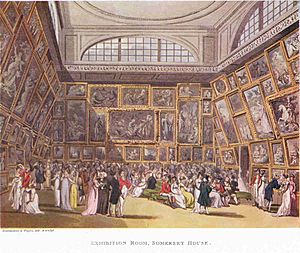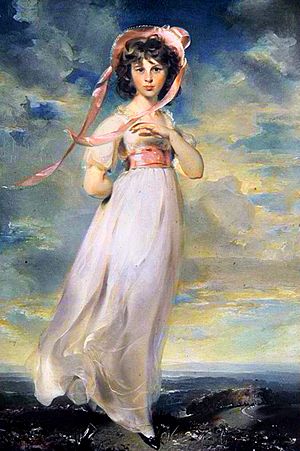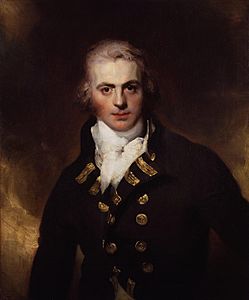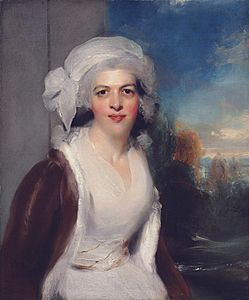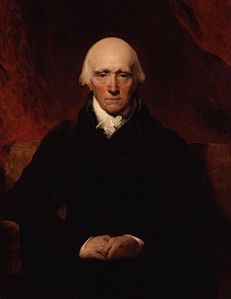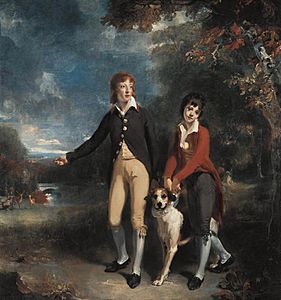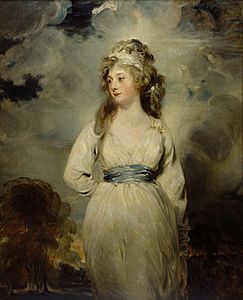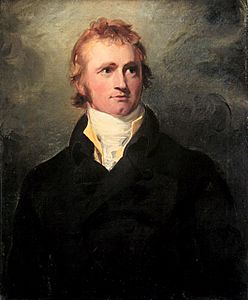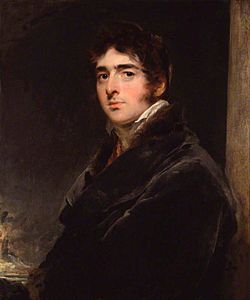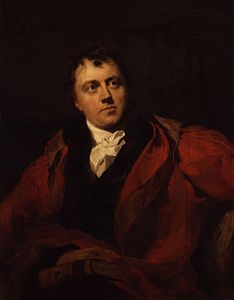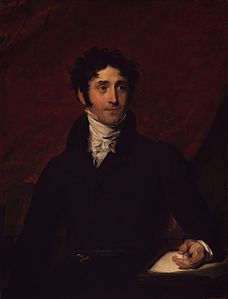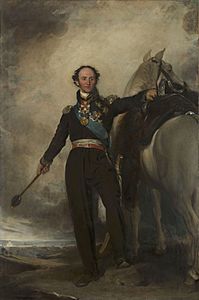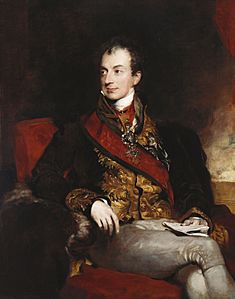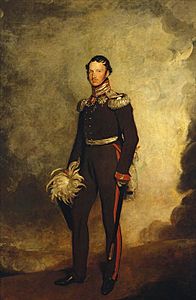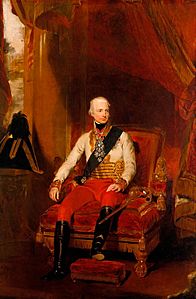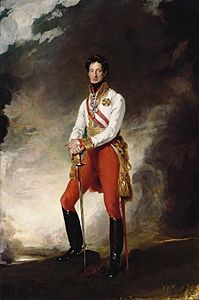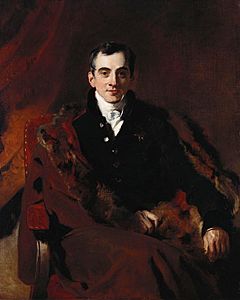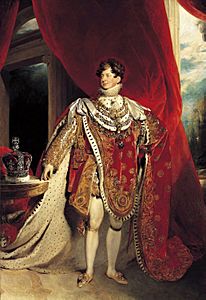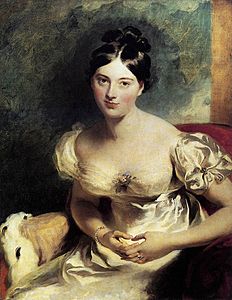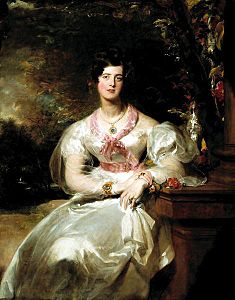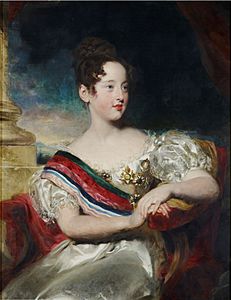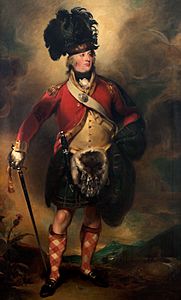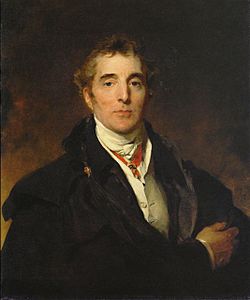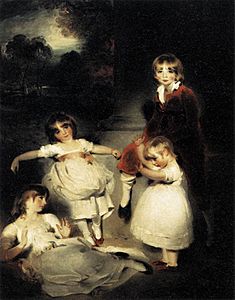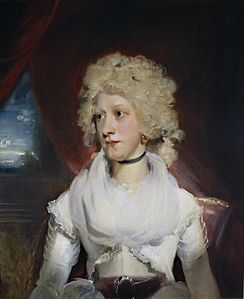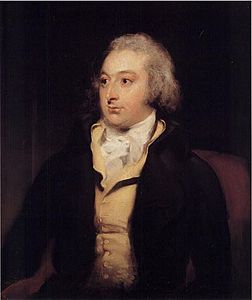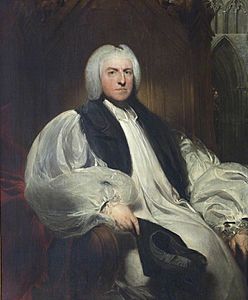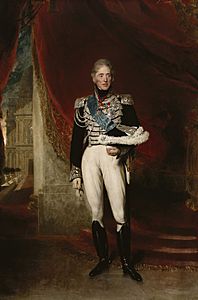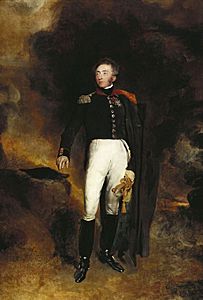Thomas Lawrence facts for kids
Quick facts for kids
Thomas Lawrence
PRA FRS
|
|
|---|---|

Self-portrait, 1788
|
|
| Born | 13 April 1769 Bristol, England
|
| Died | 7 January 1830 (aged 60) London, England
|
| Resting place | St Paul's Cathedral |
| Known for | Painting |
| Movement | Romanticism |
Sir Thomas Lawrence (born April 13, 1769 – died January 7, 1830) was a famous English portrait painter. He became the fourth president of the Royal Academy, a leading art institution.
Thomas was a child genius. He was born in Bristol, England, and started drawing when he was very young. His father ran an inn in Devizes. By the age of ten, after moving to Bath, Thomas was already earning money for his family by creating pastel portraits.
When he was 18, he moved to London. He quickly became known for his oil paintings. In 1790, he received his first royal job: painting a portrait of Queen Charlotte. He remained a top artist until he passed away at 60 years old in 1830.
Thomas Lawrence taught himself how to paint. He was excellent at drawing and capturing a person's true look. He was also known for his amazing way of using paint. He joined the Royal Academy in 1791, became a full member in 1794, and was chosen as president in 1820.
In 1810, he gained the support of the Prince Regent, who later became King George IV. The Prince Regent sent him to other countries to paint portraits of important leaders. These paintings were for the Waterloo Chamber at Windsor Castle. Lawrence is especially remembered as a Romantic portrait painter of the British Regency period.
Lawrence's personal life was sometimes difficult, and he never married. Despite his success, he often had money problems. When he died, he was the most popular portrait painter in Europe. His fame faded a bit during Victorian times, but his work is now more appreciated again.
Contents
Biography
Early Life and Art
Thomas Lawrence was born in Bristol. He was the youngest of many children, but only five lived past infancy. His father, Thomas Lawrence, first worked for the government. Later, he decided to run inns. The family moved to the Black Bear Inn in Devizes in 1773. This inn was a popular stop for wealthy people traveling to Bath.
During their six years at the Black Bear Inn, Thomas's father showed off his son's amazing talents. Young Thomas could draw very well and recite poetry. Visitors would often be asked, "Gentlemen, here's my son—will you have him recite from the poets, or take your portraits?" Even the famous actor David Garrick heard Tom recite.
Thomas didn't have much formal schooling. He went to a school in Bristol for two years and had some lessons in French and Latin. He also learned dancing, fencing, boxing, and billiards. By age ten, he was so famous that a writer named Daines Barrington mentioned him. Barrington wrote that Thomas could copy historical paintings "without the most distant instruction from anyone."
However, his father's inn business failed again. In 1779, the family went bankrupt and moved to Bath. From then on, young Thomas supported his parents with his art.
In Bath, the family settled at 2 Alfred Street. Thomas became a successful portrait artist using pastels. His oval portraits were about 12 by 10 inches (30 by 25 centimeters) and usually showed the upper body. He charged three guineas for each. Many important people sat for him, including the Duchess of Devonshire and the actress Sarah Siddons.
Thomas was talented, charming, and modest. He was very popular in Bath. Other artists, William Hoare and Mary Hartley, encouraged him. Wealthy people let him study their art collections. He even won a silver-gilt palette and 5 guineas from the Society of Arts in London for his drawing of a copy of Raphael's Transfiguration.
A Rising Star in London
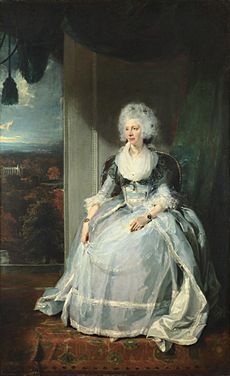
Before his eighteenth birthday in 1787, Thomas Lawrence moved to London. He lived near the studio of the famous painter Joshua Reynolds. Reynolds advised him to study nature rather than just old paintings. Lawrence set up his own studio and helped his parents move to London.
He showed several paintings at the 1787 Royal Academy exhibition. He also enrolled as a student there but didn't stay long. He preferred to focus on his portrait painting rather than drawing classical statues.
In 1788, he showed five pastel portraits and one oil painting at the Royal Academy. He quickly became skilled with oil paints. From 1787 until his death in 1830, he only missed two annual exhibitions. In 1789, he showed 13 portraits, mostly in oil. Critics praised his work, with one calling him "the Sir Joshua of futurity not far off."
At just 20 years old, Lawrence received his first royal job. He was asked to paint Queen Charlotte and Princess Amelia at Windsor Palace.
The Queen found Lawrence a bit too confident, but he made a good impression on the princesses. The Queen did not like her finished portrait, and it stayed in Lawrence's studio until he died. However, when it was shown at the Royal Academy in 1790, critics loved it. That same year, he also showed another famous portrait of actress Elizabeth Farren. A newspaper described it as "completely Elizabeth Farren: arch, spirited, elegant and engaging."
In 1791, Lawrence was chosen as an associate of the Royal Academy. The next year, after Sir Joshua Reynolds passed away, King George III named Lawrence his "painter-in-ordinary." His reputation was now firmly set. He moved his studio to Old Bond Street. In 1794, he became a full member of the Royal Academy.
Even though he had many painting jobs, Lawrence often had money problems. His debts stayed with him for the rest of his life. He almost went bankrupt and had to be helped by wealthy friends. He died without much money. People aren't sure why he had so much debt. He worked very hard and didn't seem to spend a lot. Some say it was because he was very generous to his family and friends. He also had a valuable but expensive collection of old master drawings.
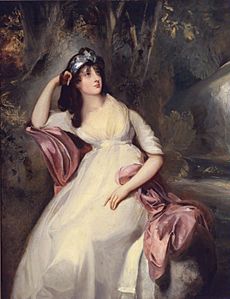
Lawrence's personal relationships were complicated. He never married. He had a strong friendship with Isabella Wolff, who sat for her portrait in 1803.
Lawrence rarely painted anything other than portraits. In the early 1790s, he painted two historical scenes. One was Homer reciting his poems, a small picture of the poet. The other was Satan summoning his legions, a huge painting based on John Milton's Paradise Lost. The boxer John Jackson posed for Satan's body. The face was that of Sarah Siddons' brother, John Philip Kemble.

Lawrence's parents passed away in 1797. He moved his studio to the family home in Greek Street. To keep up with the many requests for copies of his portraits, he started using assistants like William Etty and George Henry Harlow.
In the early 1800s, Lawrence's portrait business continued to do very well. He painted important political figures like Henry Dundas, 1st Viscount Melville and William Lamb, 2nd Viscount Melbourne. He also painted Lady Caroline Lamb, William Lamb's wife. The king asked him to paint his daughter-in-law Caroline and his granddaughter Charlotte. Lawrence stayed at the princess's home while painting. He was involved in a royal investigation about Caroline but was cleared of any wrongdoing.
The Artist of the Regency Era
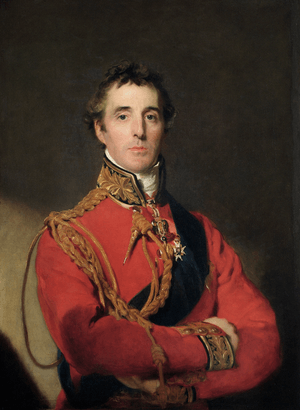
By 1811, when the Prince of Wales became regent, Lawrence was known as the best portrait painter in the country. The Prince Regent became his most important supporter. He commissioned portraits of himself and allied leaders like the Duke of Wellington, Field-Marshal von Blücher, and Count Platov. These leaders sat for Lawrence at his new house in Russell Square.
The Prince Regent also planned for Lawrence to travel and paint foreign royalty. As a first step, Lawrence was made a Knight Bachelor on April 22, 1815. This meant he could use "Sir" before his name. Napoleon's return from Elba put these travel plans on hold. However, Lawrence did visit Paris and saw art that Napoleon had taken from Italy, including Raphael's Transfiguration, which he had copied as a boy.

In 1817, the prince asked Lawrence to paint his daughter Princess Charlotte, who was expecting her first child. Sadly, Charlotte died during childbirth. Lawrence finished the portrait and gave it to her husband Prince Leopold on his birthday.
Finally, in September 1818, Lawrence made his trip to Europe. He painted allied leaders first at Aachen and then at the conference in Vienna. These paintings became the famous the Waterloo Chamber series, which is now at Windsor Castle. He painted Tsar Alexander, Emperor Francis I of Austria, the King of Prussia, and many other important figures. In May 1819, still following the Prince Regent's orders, he went to Rome to paint Pope Pius VII and Cardinal Consalvi.
President of the Royal Academy
Lawrence returned to London on March 30, 1820. He found out that the president of the Royal Academy, Benjamin West, had died. That very evening, Lawrence was voted the new president. He held this important position for ten years until his death.
King George III had died in January, and Lawrence was part of the procession for George IV's coronation. On February 28, 1822, he was chosen as a Fellow of the Royal Society for his great skill in art.
Royal painting jobs continued in the 1820s. He painted the king's sister Sophia and the famous writer Sir Walter Scott. He also traveled to Paris to paint King Charles X of France for the Waterloo series. Lawrence gained another important supporter in Robert Peel, who asked him to paint his family and George Canning.
Two of Lawrence's most famous portraits of children were painted in the 1820s. One was of Emily and Laura Calmady, daughters of Charles Calmady. The other was of Master Charles William Lambton, known as The Red Boy. This painting was very popular when shown in Paris in 1827. One of his last jobs was painting the Earl of Aberdeen, who would later become prime minister.
Sir Thomas Lawrence died suddenly on January 7, 1830. He had felt chest pains a few days before but kept working. Doctors later said his death was caused by problems with his heart. Lawrence was buried on January 21 in the crypt of St Paul's Cathedral. The artist J. M. W. Turner was among those who attended the funeral.
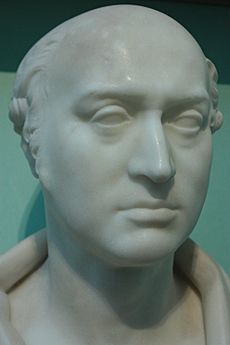
Lawrence was known for taking a long time to finish some paintings. When he died, his studio had many unfinished works. Some were completed by his assistants or other artists. In his will, Lawrence offered his collection of Old Master drawings to the king and then to the British Museum. No one accepted the offer at the time, so the collection was sold off. Many of these drawings later ended up in the British Museum and the Ashmolean Museum. After his debts were paid, there was no money left from his estate. However, an exhibition of his work raised £3,000, which was given to his nieces.
Legacy
Lawrence's friends asked the poet Thomas Campbell to write his life story. Campbell passed the task to D.E. Williams, who published two books in 1831. Other biographies followed over the years, including works by Lord Ronald Gower and Sir Michael Levey.

Lawrence's reputation as an artist declined during the Victorian era. However, the critic Roger Fry helped to restore it in the 1930s. At one point, Lawrence was more popular in the United States and France than in Britain. Some of his most famous portraits, including those of Elizabeth Farren, Sarah Barrett Moulton (known as Pinkie), and Charles Lambton (the "Red Boy"), were bought by American collectors in the early 1900s.
Sir Michael Levey, an art expert, noted that Lawrence was a very original artist. He taught himself and developed his own unique style. He didn't have many students or a lasting influence on other painters. Levey suggested that his only real successor in art was in photography, not painting.
The largest collections of Lawrence's work are held by the Royal Collections and the National Portrait Gallery in London. Other museums in London, like the Tate Britain and the National Gallery, also have some of his paintings. In the United States, The Huntington Library has Pinkie, and the Metropolitan Museum of Art has his portraits of Elizabeth Farren and the Calmady children. The Musée du Louvre in Europe and the Vatican Pinacoteca also have examples of his art.
In 2010, the National Portrait Gallery held a special exhibition of Lawrence's work. The director, Sandy Nairne, said that Lawrence was "a huge figure" who deserved more attention. He called him "one of the great painters of the last 250 years and one of the great stars of portraiture on a European stage." In 2018, a portrait by Lawrence sold for £2.29 million at auction, setting a new record for the artist.
In Literature
Sir Thomas Lawrence's art has been mentioned in several famous books and plays:
- In the 1848 novel Vanity Fair by William Makepeace Thackeray, Lawrence's portraits are described as "tawdry and beautiful."
- Letitia Elizabeth Landon wrote a poem called Sir Thomas Lawrence in 1833, paying tribute to the artist.
- Charles Dickens mentioned Lawrence 25 times in his 1857 novel Little Dorrit.
- In Oscar Wilde's 1895 play An Ideal Husband, a character is described as looking "rather like a portrait by Lawrence."
- In the 1943 film The Man in Grey, Lawrence is played by actor Stuart Lindsell.
Gallery
-
The Two Sons of the Earl of Talbot, 1793, Neue Pinakothek
-
Lord Mount Stuart, 1795
-
Alexander MacKenzie, (c.1800-1801), National Gallery of Canada
-
Princess Charlotte of Wales, circa 1801
-
William Lamb, later Viscount Melbourne, c.1805
-
King George III in State Opening of Parliament dress, 1809
-
Thomas Campbell, circa 1810
-
Lady Hinchingbrook as "Hope"
-
Austrian Chancellor Klemens von Metternich, c.1815
-
Emperor Francis I of Austria, c.1818
-
Archduke Charles, 1819
-
Count John Capo d'Istria, between 1818 and 1819, Royal Collection
-
King George IV's coronation
-
Portrait of Marguerite, Countess of Blessington, 1822, Wallace Collection, London
-
Lady Maria Conyngham, 1824–25, Metropolitan Museum of Art
-
Queen Maria II of Portugal
-
Miss Marthe Carr (Museo del Prado)
-
Shute Barrington (Merton College, Oxford)
-
Sir Walter Scott, 1820s
-
King Charles X of France, 1825
-
King William IV, then Duke of Clarence
See also
 In Spanish: Thomas Lawrence para niños
In Spanish: Thomas Lawrence para niños
- English school of painting


